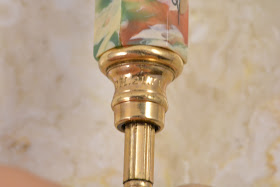This article has been edited and included in The Leadhead's Pencil Blog Volume 5; copies are available print on demand through Amazon here, and I offer an ebook version in pdf format at the Legendary Lead Company here.
If you don't want the book but you enjoy this article, please consider supporting the Blog project here.
Here are a couple nice Victorian pieces with something in common:
Both have distinctive mother of pearl slabs, and usually, these are stamped “Pearl Pat. Dec. 5 ‘71,” a reference to patent number 121,627 issued to Ephraim S. Johnson:
These two examples, though, have a twist – on figuratively, one literally. The conventional magic pencil shown at the bottom is larger than average size, measuring a hair longer than four and a half inches extended (4 3/4" if you count the ring on top).
Instead of the Pearl patent imprint you’d expect to see, though, this one is stamped only Aikin, Lambert & Co.:
This is the only Aikin Lambert I’ve seen with the pearl slab treatment. I don’t think it was made after Johnson’s patent expired, but it might have been. Cross-licensing of patents appears to have been the norm amongst New York manufacturers; in fact, I found this fascinating piece in the June 16, 1892 issue of
The American Stationer, in which all of the major houses, including both Aikin, Lambert & Co. and E.S. Johnson, agreed to “stop the competition” and establish a secret price-fixing schedule:
That was the figurative twist. Now for the literal one: that other pearl-slabbed item has a much larger diameter, because there’s a lot going on inside.
At one end, the extender can be pulled out and then the top end twisted to advance a Rauch-like mechanical pencil:
Then here’s the twist: by turning the entire extension tube, a dip pen nib is advanced, in much the same way as a much later safety fountain pen:
The nib is a Mabie Todd Number 5, maybe it is original, but of course it might have been a replacement.
The patent markings are on the pencil end. On one side is Johnson’s December 5, 1871 patent:
But on the other is a patent date I had not run across before: July 3, 1866:
It’s times like these when I’m glad I wrote
American Writing Instrument Patents 1799-1910, since it certainly hasn’t been those times when I’ve waited for it to hit the best seller list in the New York Times. There was no fumbling around trying to find the patent . . . I just opened up the book to that date, and there it was:
The date refers to James M. Clark’s patent number 56,007. Since the presence of Johnson’s patent date on the piece suggested more of a connection between Johnson and Clark (as we saw with the Aikin Lambert, others who merely licensed a patent wouldn’t also include the patent date), I turned to another portion of my book which excels at distilling relationships between makers, and there it was:
In the section of the book in which patents are organized by inventor, there are five patents issued to James M. Clark. This one, number 118,434, was issued on August 29, 1871, just four months before Johnson’s pearl patent – and this patent was assigned to Ephraim S. Johnson.
For the time being, I’ve placed this example on my shelf, alphabetized under Clark rather than Johnson. There are three other Clark patents out there, and finding examples of each might better establish whether Clark was a manufacturer in his own right, whether he sold or licensed patents to several New York makers, or whether he was merely an employee of Ephraim S. Johnson.




























































